Time to say “Banzai” – the Imperial Japanese forces land in Flames of War
After many years of games and painting WWII armies from North Africa and Europe, we can finally leave the Old World and travel to the Far East: Battlefront is about to release the highly anticipated Pacific expansion for Flames of War.
As we saw in Tom Gall’s preview, the new book is already shaping up to be a “compendium” of over 170 pages, covering the armies that fought in Southeast Asia. It includes the US Marines, the British Commonwealth and their Indian and Australian allies, and of course, the Japanese—who will be the focus of this article.
Pacific is a Mid-War period book, with a points system compatible with the other Mid-War releases for WWII. It should soon be available online on Forces, likely with a “Dynamic 2.0” version and including updated point costs developed by Battlefront and the Flames of War community over the past 24 months. In this article, we’ll take a closer look at the point values in the book, bearing in mind that light tanks will likely see a notable cost increase, considering how L6s or Crusaders have been adjusted in other Mid-War lists.
The Japanese army, win or lose with a glorious charge
The Japanese army is unique: its main strength lies in its unstoppable assault infantry, which the generals of the Rising Sun relied on to break through enemy lines. Let’s begin with the Imperial Army’s “special rules.”
The first rule, appropriately named Banzai, defines the character of the entire army. While assaulting infantry in British, German, Russian, or other FOW-derived systems as Team Yankee can typically be stopped by defensive fire, Japanese assaults are relentless. If you’re defending a position and a platoon of Japanese infantry charges you, you might hit them 70 times, but they’ll still reach you—or die trying to the last man.
In fact, while infantry in other Battlefront games can be stopped by just five successful defensive fire hits (regardless of whether those hits cause casualties), Japanese infantry ignore defensive fire entirely. On the other hand, their reckless bravery makes them more vulnerable: Japanese infantry charging into assault (important—only when charging) save on a 4+ instead of the standard 3+.

Banzai rule is very effective – now all you just need to do is assault by night, with smoke protection, in terrain and pin down the assaulted units.
Also, Japanese infantry assault at six-inche instead of the usual four-inch (and beware, that includes Sneak On Attack). Another distinctive trait is that Banzai units can never break off—they are expected to fight to the last man. This rule, as seasoned Flames of War veterans may have already guessed, will heavily influence your tactics when playing with—or against—the Japanese army.
Two additional special rules also have a significant impact on how your battles will play out on both sides of the Japanese bayonets.
Night Attack allows nearly all Japanese infantry units to launch assaults under the cover of darkness—not only in the standard Attack vs. Defend scenario, but even when the defender has laid minefields. This includes several More Missions scenarios in the Attack vs. Maneuver category.
Jungle Craft, on the other hand, emphasizes the Japanese soldiers’ superior mobility in difficult terrain, giving them a 12-inch Terrain Dash. That means difficult ground becomes a perfect highway for their assaults—offering both better protection (especially at night) and a faster pace that, in many More Missions scenarios, will allow Japanese troops to charge enemy lines from turn one.
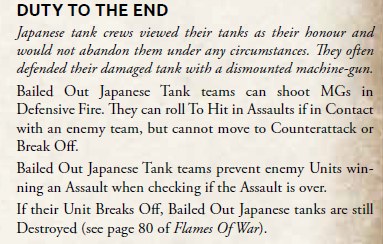
Among other noteworthy special rules—aside from the familiar Flame-throwers and Pioneers similar to those in other armies—Japanese tanks also stand out for their unnatural stubbornness. The rule Duty to the End allows “bailed out” Japanese tanks to fire defensive machine guns during enemy infantry assaults (something tanks normally can’t do when bailed out). Even more impressively, they can actually win assaults, meaning you’ll need to destroy them all—or force them to fail a Counterattack test—to clear them from your lines.
Lastly, there’s Artillery Burst, a rule designed for Japanese artillery units, which are usually limited to just two guns. When firing bombardments, those two guns count as four, meaning they avoid the dreaded re-roll for small templates. Just be aware—it doesn’t apply when firing smoke.
Japanese Formations
Let’s take a look at the Japanese formations. Here’s their order of battle.

Reflecting the historical situation, the Japanese can rely on both Imperial Army and Navy formations—two branches that, historically, weren’t exactly famous for cooperating enthusiastically with each other.
Tank Formations
The Army can field three light tank formations and, naturally, an infantry formation. The Navy brings one tank formation and one Naval Infantry formation.
Let’s start with the tanks. All Japanese crews have 3+ Morale, 4+ Skill, and—as expected—are hit on 3+ as the rest of the entire army (except the Observer). All of them also have Night Attack, meaning they’ll join in night assaults even when taken as divisional support.

The Type 97 Chi-Ha is a solid light tank. The formation includes an HQ with two tanks and three platoons of 3–5 tanks each, with a cost that ranges from 4 to 7 points. As mentioned earlier, this cost will very likely increase by at least a third under the “Dynamics 2.0” update, aligning with the general rise in light tank costs across Mid-War lists.
At the moment, they’re quite affordable—about 1.2 points per tank gets you a vehicle with Front Armour 3, Side 2, Top 1, and a gun with AT 5 / Firepower 3+, although it’s Overworked (meaning an additional -1 to hit if it moves before shooting). Our preferred configuration is the 1-point-per-tank upgrade that equips them with an more than decent AT 8 / FP 4+ gun (Overworked and No HE, making them worse against infantry and gun teams).
The Type 97 is a great tank to deal with the swarms of “mini-vehicles” you typically see in Mid-War FoW tables, but they’re essentially useless against heavy tanks from Russian or German lists.

The formation is rounded out with an ultra-light scout unit: the TE-KE Tankettes. Armour 2/1/1, with Scout and Spearhead, but armed with only 3 MGs. They currently cost 1 point per tank, but you can pay 1 point extra for the entire unit to upgrade their weapon to a more useful AT 6 / FP 4+ Overworked gun.
Alternatively, you have the Type 94 TK, which costs less than 1 point per tank, have armour made of reinforced cardboard (1/1/1), and carry just MGs.
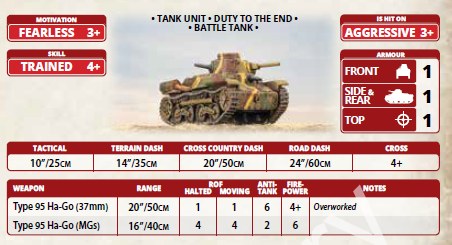
The second tank unit available to Japanese Army generals is the Type 95 Ha-Go, which we might define as ultra-light tanks. Their armour would make a medieval knight jealous: 1/1/1, with a AT 6 / FP 4+ Overworked gun that fires just once while stationary. On the other hand, they carry 4 MGs and move decently through rough ground (14”). They cost 1 point each.

Then we have the Type 89 Chi-Ro, which has a nearly unique trait. Despite being a light tank with just 1 Front and Side Armour, it has Top Armour 2. This means that when it assaults enemy infantry, it’s practically immune to standard rifle teams—but will be shredded by any proper AT weapon, or even by concentrated small arms fire. It has an AT 5 / FP 3+ Overworked gun and 4 MGs. We currently see it best deployed behind charging infantry to protect them from any foolhardy enemy assaults.

Finally, there are the Naval Division tanks, the Type 2 Ka-Mi. The formation includes an HQ and three platoons—no scout units. These tanks are extremely distinctive—almost steampunk—and honestly, I’ll probably paint them whether I field them or not.
Despite the impressive ship-shaped armor, they’re just as lightly armored as their land-based counterparts: 1/1/1 can barely withstand more than MG fire. They carry a decent AT 7 / FP 4+ Overworked gun and the usual 4 MGs. They also have Amphibious, which allows them to treat impassable water features as difficult terrain, and a better Last Stand value of 2+.
Let’s move on to the infantry
Army Infantry is among the best in the entire game. The formation includes the standard 2-figure HQ platoon and three infantry platoons, supported by a machine gun platoon and three different gun platoons.

The core infantry is excellent, as mentioned. 4+ Morale and 4+ Skill, but with specific upgraded stats: 3+ for Counterattack, Last Stand, and Assault—very similar to the also-excellent British infantry, although the Japanese are Hit on 3+. Infantry platoons come in two sizes: a smaller one with 7 rifle teams and 2 light mortars (7 points), or a bigger one with a massive 10 rifle teams and 3 mortars (10 points).

Both versions can be upgraded with 1 additional mortar, 1 HMG (1 point each), and 2 Anti-Tank rifle teams (2 points each, AT 5). All Japanese infantry shoots with ROF 1 and Overworked, so don’t expect them to mow down dug-in enemies—these guys are made to assault, not suppress.
The HMG platoons are pretty standard: 2 or 4 stands for 2 or 4 points. ROF 6 while stationary, 2 on the move. A solid addition within the formation, but many players might prefer to rely on light tanks for covering and suppressing fire instead.
Then we have the gun teams. The Rapid Fire Platoon gives you two guns, either 37mm (AT 6) or 47mm (AT 8, No HE)—super cheap at 2 or 3 points, but again, considering Japanese tactics, tanks may be the preferred choice for most players to counter enemy light vehicles.
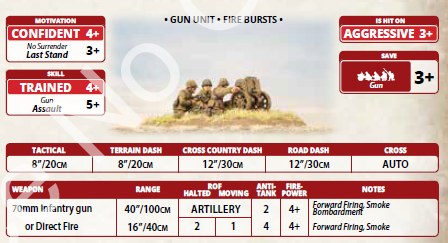
The 70mm Gun Battalion offers two artillery guns with smoke bombardment and AT 2 / FP 4+. Skill 4+ is average, but enough to pin infantry and gun teams. Only 3 points for the platoon—great value, though we’ll see how the Dynamic pricing update affects it.
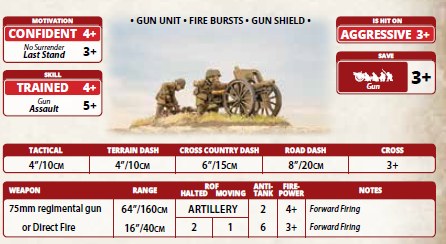
The 75mm Gun is similar but with a better direct AT 6, compared to the 70mm’s AT 4. But honestly, you won’t want these guys in direct fire too often—just two bases mean you’ll hide them as best as possible.

If Army Infantry is one of the best units in the game, Naval Infantry is possibly the best of the entire game. Very similar to their Army counterparts, but with 2+ Counterattack and Rally. They don’t get the anti-tank rifles… but who needs them when you’ve got Banzai charges to send them home?

The cost reflects their quality: 9 points for the smaller platoon, 12 for the larger one (compared to 7 and 10 for the Army version).
They also have stronger support. The Rapid Fire, 70mm, and 75mm gun platoons are all available here too—same cost, but with an upgraded Last Stand of 2+, which might actually matter when running 2-gun platoons.
They also get an 81mm mortar platoon (2 or 4 bases, 2 or 5 points), with standard AT 1 / FP 4+ and, crucially, a 4-template smoke barrage—possibly the only multi-template smoke option in the entire Japanese list (the other being the same platoon in Supports, as we will see in minutes).
More interestingly, the Naval Infantry has access to two AA gun platoons:

- A super cheap 20mm AA, with ROF 3 / AT 5 / FP 5+, 4 points;
- The 75mm AA gun, an excellent multi-role gun with AT 10 / FP 3+, for 9 points. Only 32” range, but still better than anything else the Japanese have to counter medium tanks. Four guns cost 8 points.
Support Units


The Engineer Platoon is another very solid infantry unit, similar to the Army one but with the extra Pioneer ability (3+ to cross Minefields). Expect Japanese armies to run into lots of minefield protected enemies—these guys are a great tool. The full unit includes 11 infantry stands and 2 flamethrowers for 11 points, with cheaper versions available.
Scout and Naval Scout platoons are small units with Scout and Spearhead. These can be sneaky thanks to Concealed and Gone to Ground when stationary, but with only 4 stands for 4 or 5 points, they’re a bit too fragile to rely on.
There’s also a 4-base mortar platoon, similar to the Naval version. A good, cheap way to deliver some indirect fire and long chains of smoke.
For barrage options, there’s the 75mm gun battery (2 elements for 5 points, AT 2 / FP 4+ with smoke), and the much better 105mm guns, 2 pieces for 6 points (AT 3 / FP 3+). All mortars and gun batteries allow the inclusion of a precious Observer team, which is almost mandatory in a force where HQ units will be constantly advancing while artillery stays hidden and far back. It’s also the only Japanese unit hit on 4+!
Again, the same AA guns found in the Naval list are available here too, with the same cost, although with a slightly worse Last Stand.

And last but not least: the legendary Zero plane—two MGs (AT 5 / FP 5+) and bombs (AT 3 / FP 2+) for 8 points.
Monsters & What-ifs
The “Pacific” book also includes some “monsters”—tanks that were either theoretical or extremely rare. Perfect for friendly games or “what if” scenarios, but you’re unlikely to see them in serious tournaments.
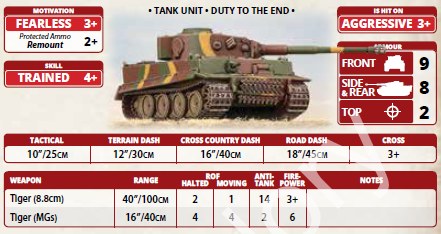
Well, in the Lost TV Shows we saw some Ferdinands, so why not a Tiger in the Pacific?
- The Tiger (yes, that Tiger), supposedly lent by their German allies. 23 points for a Tiger with 4+ Morale, 2+ Remount, and a crew that fires MGs even when bailed out. Fun, but very out of place in the Pacific!
- Also present in the fantasy section, the Type 4 Chi-To, a prototype tank designed to counter the Sherman. Over double the armor of any real Japanese tank (7/3/1) and a powerful AT 12 gun. Costs around 12.5 points per tank, and definitely looks intimidating on the tabletop.
- Slightly more grounded is the Type 1 Ho-Ni, a self-propelled gun that actually saw limited late-war service (though post-Mid-War). 7 points per vehicle, 2–3 units per platoon. Has a strong 80” bombardment range, AT 3 / FP 3+, smoke barrage, and decent armor (5/4/0). Still, given all the other cheap Japanese options, it’s hard to justify this one.
Painting
The book ends with a very brief, one-page painting guide. Japanese tanks have a distinctive three-tone camouflage pattern, and sometimes wild-looking bright yellow cross-stripes for air recognition. If you want to paint a Japanese army, check out Osprey books or some good internet references—this is a force that will truly stand out on the tabletop.

A couple of army lists.
Let’s try to go extreme. If you want to play with only infantry, and without doubling the same formations, you can have a lot of infantry bases indeed.
Infantry Formation
HQ – 2 small bases – 2 points
Infantry Platoon #1 – 10 infantry, 4 mortars, 1 HMGs – 12 points
Infantry Platoon #2 – 10 infantry, 4 mortars, 1 HMGs – 12 points
70mm Gun – 3 points
75mm Gun – 3 points
Naval Infantry Formation
HQ – 2 small bases – 2 points
Naval Infantry Platoon #1 – 10 infantry, 4 mortars, 2 HMGs – 15 points
Naval Infantry Platoon #2 – 10 infantry, 4 mortars, 2 HMGs – 15 points
Naval Infantry Platoon #3 – 10 infantry, 4 mortars, 2 HMGs – 15 points
Mortar – 4 bases – 5 points
70mm Gun – 3 points
Support
Engineer Platoon – 11 infantry, 2 flamers – 11 points
Scouts Platoon – 3 bases -3 points
Observer – 1 point
Be ready with the brushes. It’s a 99-point army with 101 infantry small and medium bases, and 4 artillery units, each with smoke barrages. There’s also 1 point for the Lucky card, in case a counter-assault goes very badly.
All tank army
Type 97 CHI-HA Tank Company
HQ with 47mm Guns – 2 tanks – 5 points
Type 97 CHI HA Platoon #1 – 5 tanks all with 47mm upgrade (AT 8) – 12 points
Type 97 CHI HA Platoon #1 – 5 tanks all with 47mm upgrade (AT 8) – 12 points
Type 97 CHI HA Platoon #1 – 5 tanks all with 47mm upgrade (AT 8) – 12 points
Type 97 TE-KE – Scout/Spearhead Platoon – 5 tanks with AT 6 upgraded guns – 6 points
Type 2 KA-MI Naval Tank Company
HQ 2 tanks – 3 points
Type 2 KA-MI Platoon #1 – 5 tanks (AT 7) – 7 points
Type 2 KA-MI Platoon #1 – 5 tanks (AT 7) – 7 points
Type 2 KA-MI Platoon #1 – 5 tanks (AT 7) – 7 points
Support
81mm Mortar Platoon – 4 points
105 mm Field Artillery – 2 Guns – 6 points
75 mm – 4 Guns AT 10 – 8 points
Observer – 1 point
90 points for an army with 37 light tanks, rushing at 16” in the open or 12” in Terrain, with 2 smoke barrages and hopefully the night to cover their advance. They can outshoot any Mid light tank formations, and once on the flanks can kill Shermans and other medium tanks, including the most common tank on these days games, the Lee/Grant. The last 10 points to form up the usual 100 points army could be spent with the Zero, or an engineer platoon to clear minefields. Obviously, this list will be probably at least 120 points with the Dynamic points, but still an interesting option.


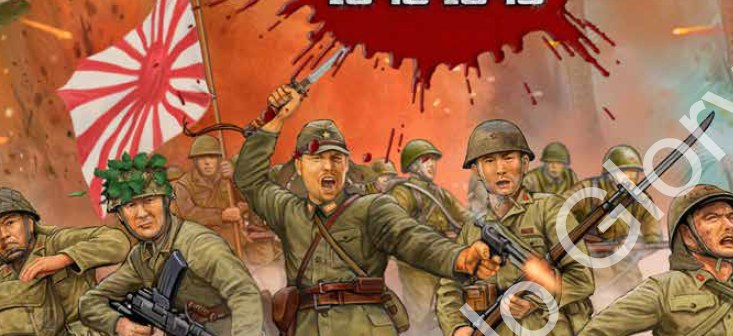
I’m assuming since most missions are going to be heavy jungle island terrain. Are Japanese Artillery units going to suffer the +1 to range in over terrain?? Or is there a special Japanese Artillery rule that covers that.